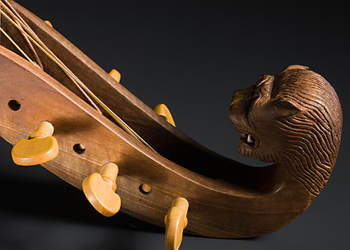|
What is it and how does the vihuela de arco sound? In spite of its appearance, the vihuela de arco (bowed vihuela) is not an instrument related to the viola da gamba or to the violin family, but with the vihuela de mano (plucked vihuela). Rather, even the plucked vihuela is derived from the bowed vihuela. At first, these instruments had fewer strings, they were polyvalent and their origins go back to the Middle Ages. In the Iberian peninsula we find the oldest and most diverse models; Such as the use of a flat bridge, double bridge or da Braccio position. Its organological characteristics, especially with respect to its construction, give it a distinct and very personal identity within the world of bowed instruments that deserve greater attention than what has been dedicated to it thus far. Because of this, the vihuela de arco sometimes sounds like an organetto of the quattrocento, other times like a dulcian or cornamuse and may even resemble the sound of an oriental bowed instrument that imitates the human voice. In any case, it was conceived in an era in where the sound of vocal polyphony and the timbre of the human voice were strived for, well before the independent development of instrumental music. Manifesto Justification This is a project dedicated to the recovery of the Art of the Bowed Vihuela; One of the most widely used musical instruments in Europe during the 15th and 16th centuries and predecessor of most modern European bowed instruments. Organologic study/reconstruction, recovery of the repertoire and above all several dicographical works serve as testimony to its authentic sound. Johannes Tinctoris, at the end of the 15th century, attributed Spanish origin ('hispanorum') to the viola de arco in order to distinguish its specific typology from the rest of European violas of the period. Other very relevant personages during Renaissance place the vihuela de arco in one of the highest artistic categories of its time. Despite this, there has not been much writen testimony of its musical practice. This discographical proposal has more than 15 years of research in organology, repertoire elaboration and historical interpretation of the vihuela de arco and it gives a much deserved tribute to the memory of such a worthy musical instrument, praised in its time and almost forgotten today. “They present the rounded and mature resultant blend to us … the intimate relationship between voice and viol, which not only does justice to the textures in which Corkine works, but even enhances his gentle intensity.” Mark Sealey, MusicWeb International sobre el CD Each Lovely Grace. William Corkine: The Second Booke of Ayres (1612)
|
"La vihuela de arco faze dulçes vayladas, adurmiendo a las vezes, muy alta a las vegadas, vozes dulces, sabrosas, claras e bien puntadas, a las gentes alegra, a todas Ayene pagadas." Arcipreste de Hita (ca.1351)
|
